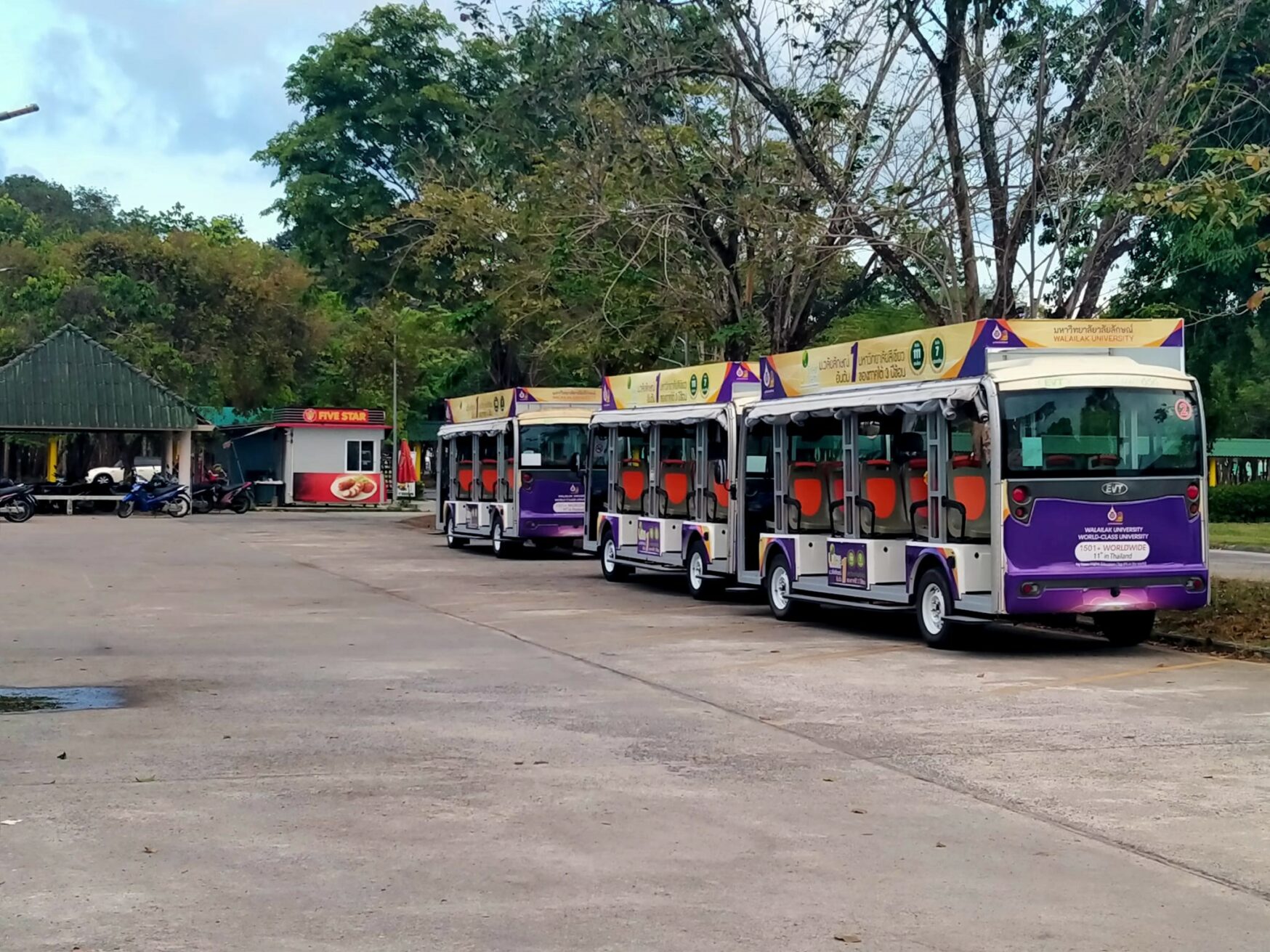Walailak University Introduces Electric Shuttle Car for Students and Staff to Promote Sustainable Commuting
Walailak University undertakes an action to utilize solar energy-powered electric shuttle buses under the project named “WU Electric Shuttle Car Service.” This transportation system is provided to serve students and staff members, making sustainable commuting within the university premises more convenient. This service is free of charge to reduce the use of personal vehicles, resulting in a decrease in accidents and damage to lives and property. Additionally, the action contributes to energy conservation by utilizing clean energy sources, thus helping reduce air and noise pollution and mitigating global warming effects. This initiative aligns a strategy to become a Smart & Green University. The electric shuttle buses are powered by a combination of electricity and solar energy, with a total of 18 buses operating on six routes. Each train has a capacity of 14 passengers. The WU Electric Shuttle Car Service was first introduced on July 14, 2018, and has continued the service for the general public.
In 2022, the university operated 20 electric shuttle buses, consisting of 13-seaters and 22-seaters. These trains serviced 7 routes within the university grounds from 07:00 a.m. to 09:00 p.m. They covered areas such as student dormitories, Classroom Buildings, the Architecture & Design Building, Lab Buildings, Academic Buildings, Sports & Health Center, Chor Praduu Food Center, Walailak Park, Walailak University Hospital, and Botanical Park. The schedule for electric shuttle bus services was adjusted to align with students’ class schedules and was updated for each academic term. The university implemented a real-time tracking system for the electric shuttle bus and monitored the performance of the operators. The satisfaction survey results from service users indicated a satisfaction rate of over 90%.

Route 1 – Academic Buildings
- Architecture & Design Building
- Anatomy Building
- The Center for Scientific and Technological Equipment
- Hua Taphan Building (Chef’s Kitchen)
- Academic Building 5
- Academic Building 9
Route 2 – Classroom Buildings
- Lan Sai Square
- Chor Praduu Food Center
- Thaiburi Hall Building
- Classroom Building 6 (ST)
Route 3 – University Front
- The Student Activity Building
- Thaiburi Hall Building
- Classroom Building 6 (ST)
- Walailak Park
- Khum Sawat Hotel
- Walailak University Center
- Applied Thai Traditional Medicine Hospital
- Thasala Hospital
Route 4 – Botanic Park
- The Student Activity Building
- Botanic Park
Route 5 – Center for Cultural and Sports Promotion
- The Student Activity Building
- Center of Cultural and Sports Promotion
Route 6 – Architecture & Design Building
- The Student Activity Center
- Architecture & Design Building
Route 7 – WU Resident Dormitory
- The Student Activity Center
- Lan Sai Square
- WU Residence

The Walailak University’s mass transit system features open and spacious electric shuttle buses that operate at an average speed of 40-50 km/h. The electric shuttle buses are equipped with semi-automatic blinds that can be manually extended and retracted, providing shade and rain protection. They also have robust handrails to prevent wind interference during transit. The electric shuttle buses have doors for boarding and alighting on the left side. Bright headlights, taillights, and interior lighting with LED lights ensure clear visibility during the day and at night. There are car horns, reverse warning signals, and clear audible turn signal indicators. LED signs display the starting and ending station for each bus, visible clearly in both daytime and nighttime
Moreover, there are security cameras installed inside and outside each bus for safety monitoring, ensuring clear visibility of all passengers. The buses are equipped with fire extinguishers. There are stop request buttons for passenger convenience.
Furthermore, WU has constructed bus stations, battery charging stations, and passenger drop-off/pick-up points. In addition, improvements have been made to pathways for easier access to buildings and footpaths connecting passengers to the closest rail station. Importantly, the system is integrated with public transportation for the convenience of students traveling to external locations such as supermarkets.
Related links of evidence:
https://green.wu.ac.th/transportation
https://www.wu.ac.th/th/news/14014
Goal 11 : Sustainable cities and communities
Goal 7: Affordable and clean energy
Goal 13: Climate action
Goal 17: Partnership for the goals

